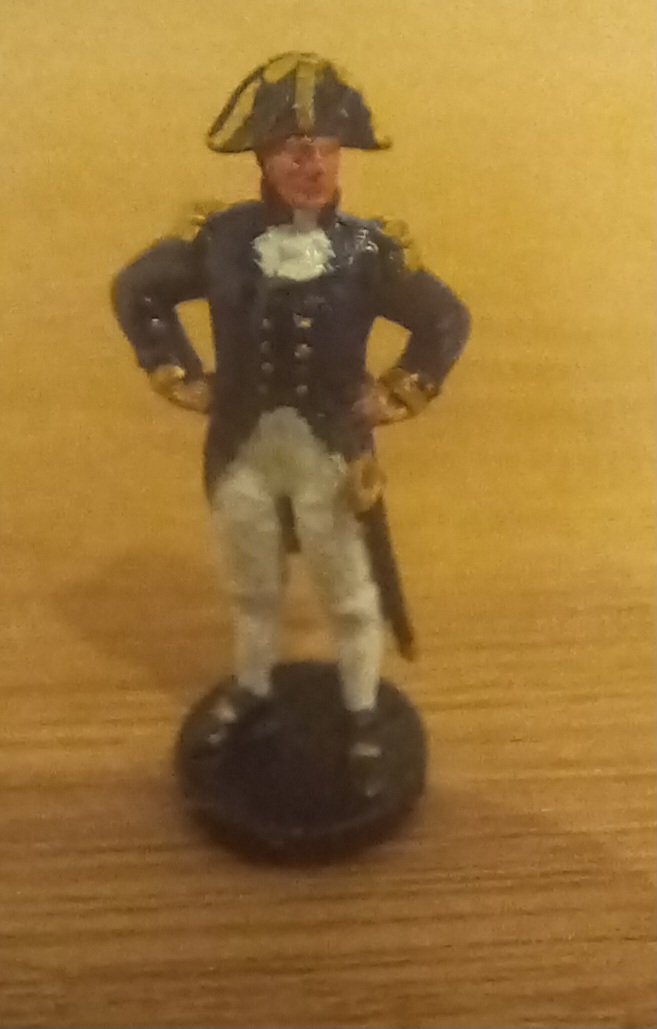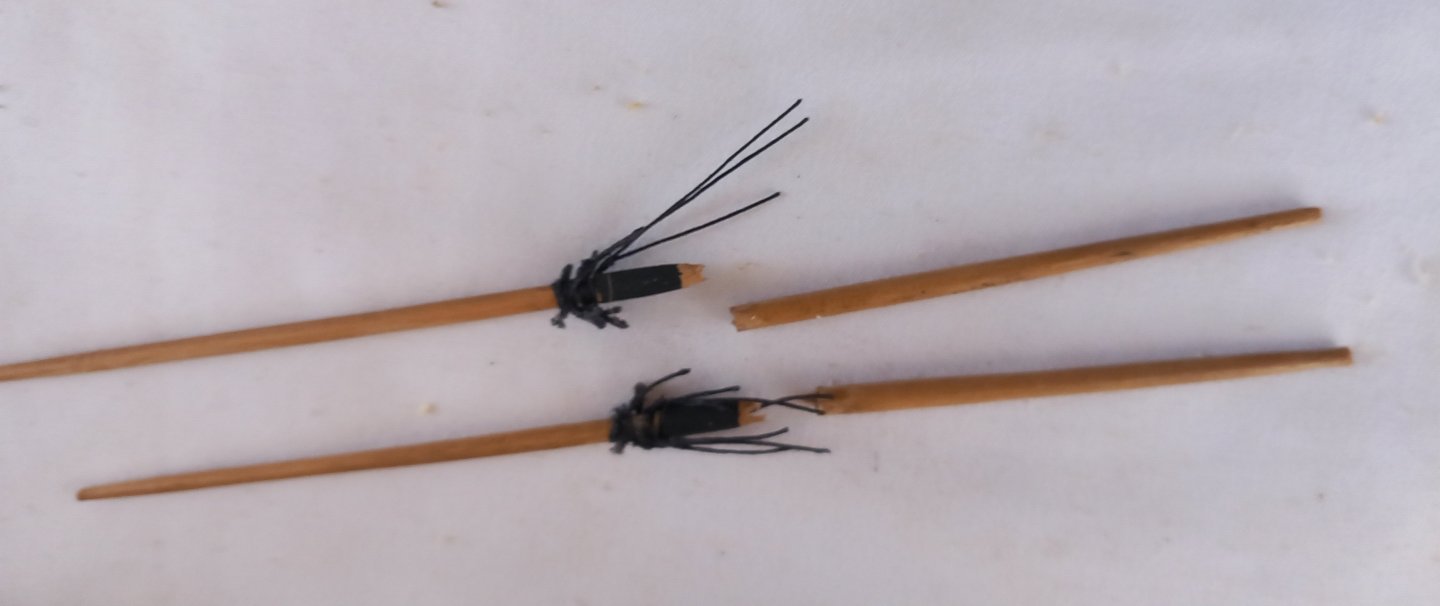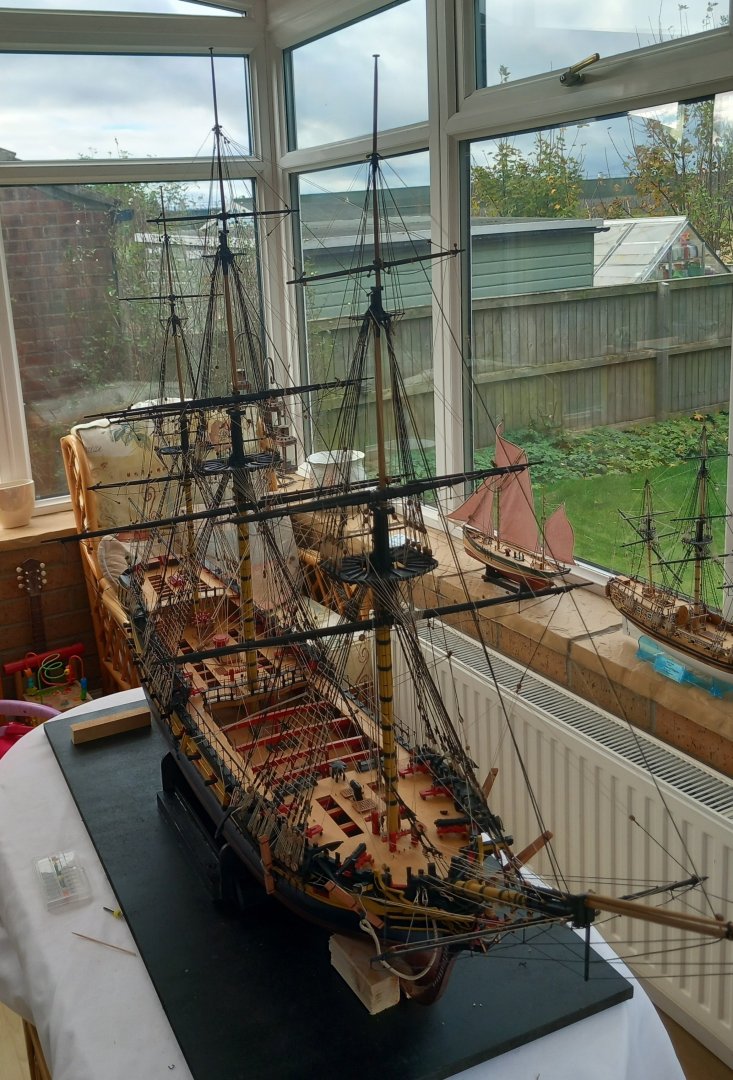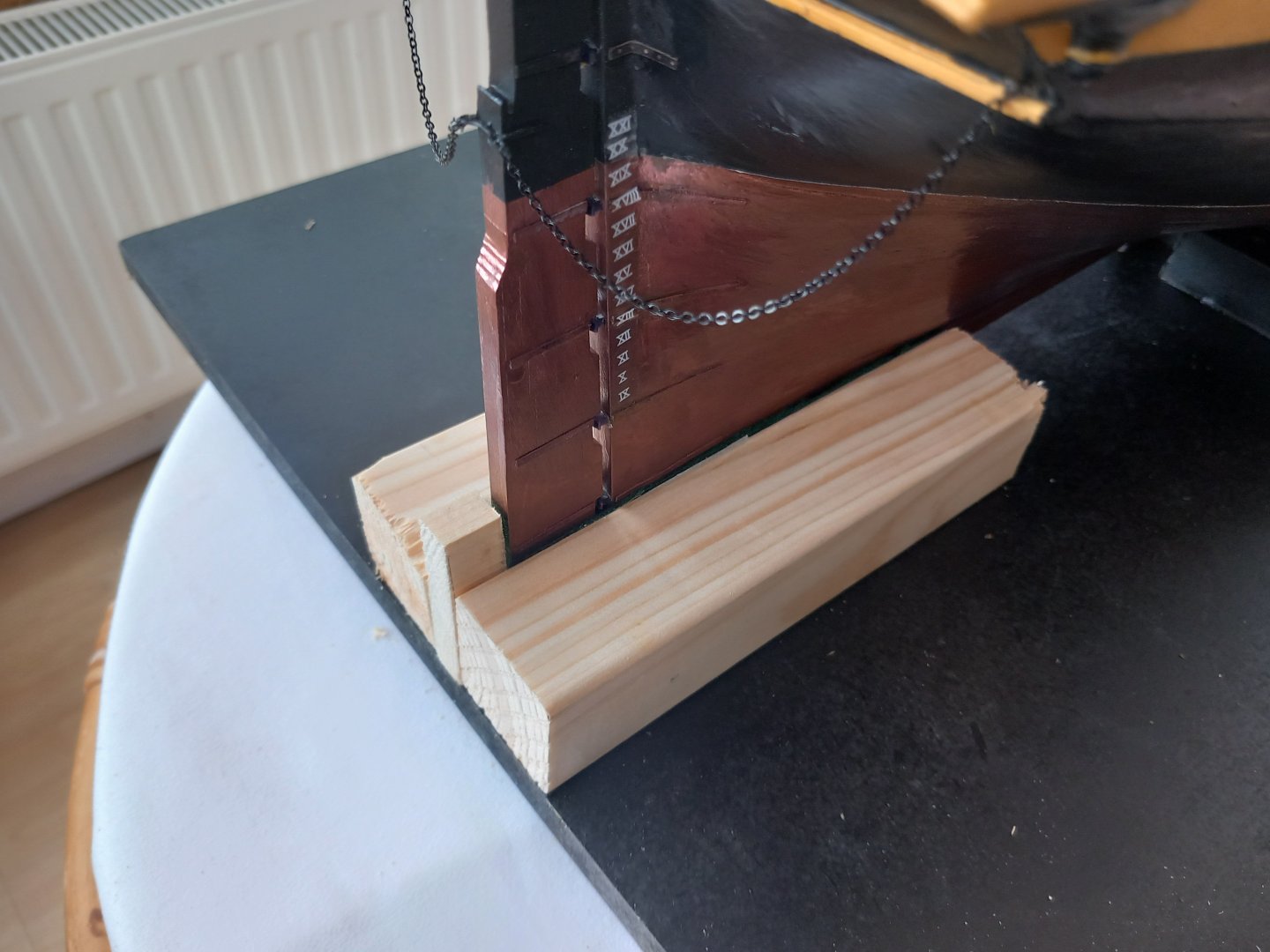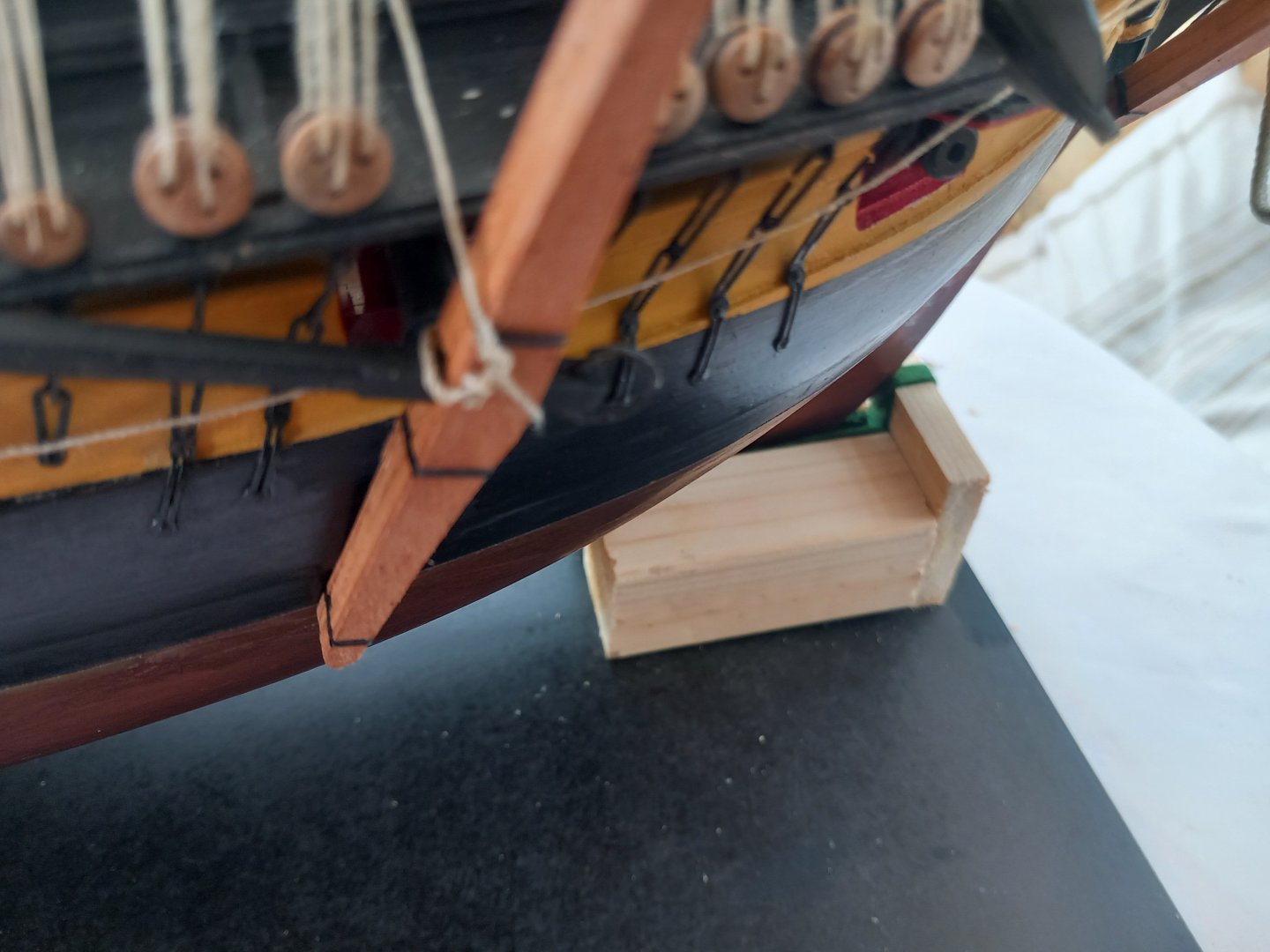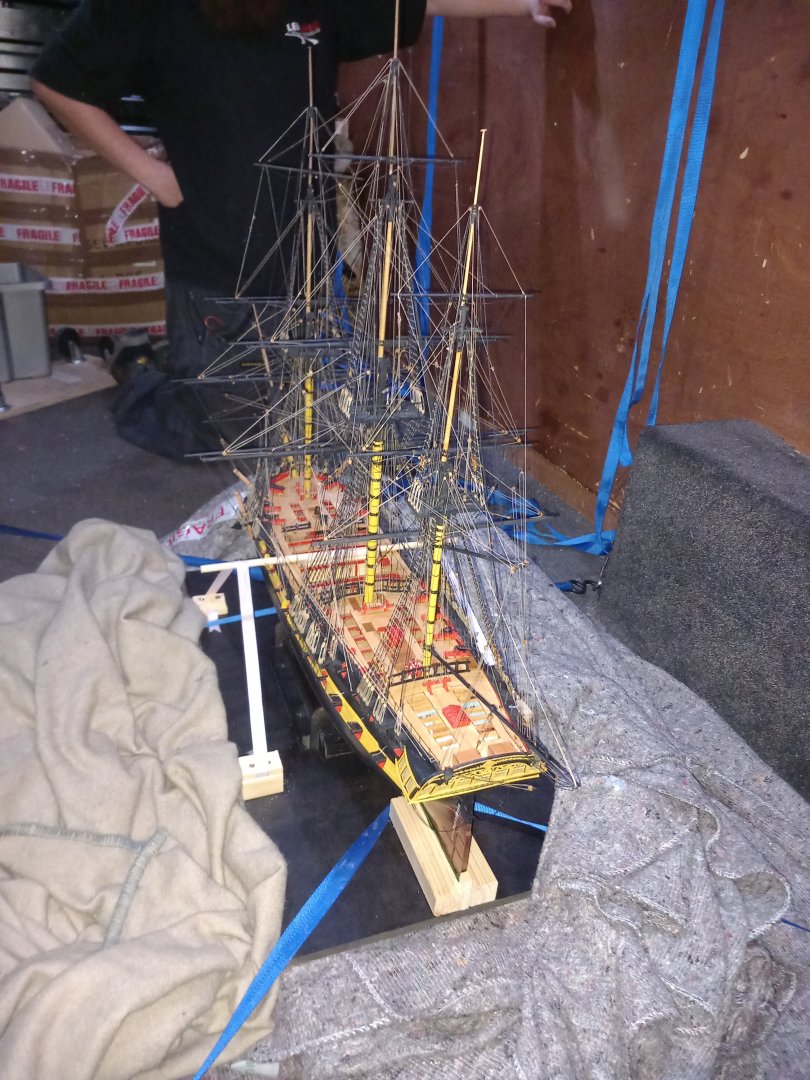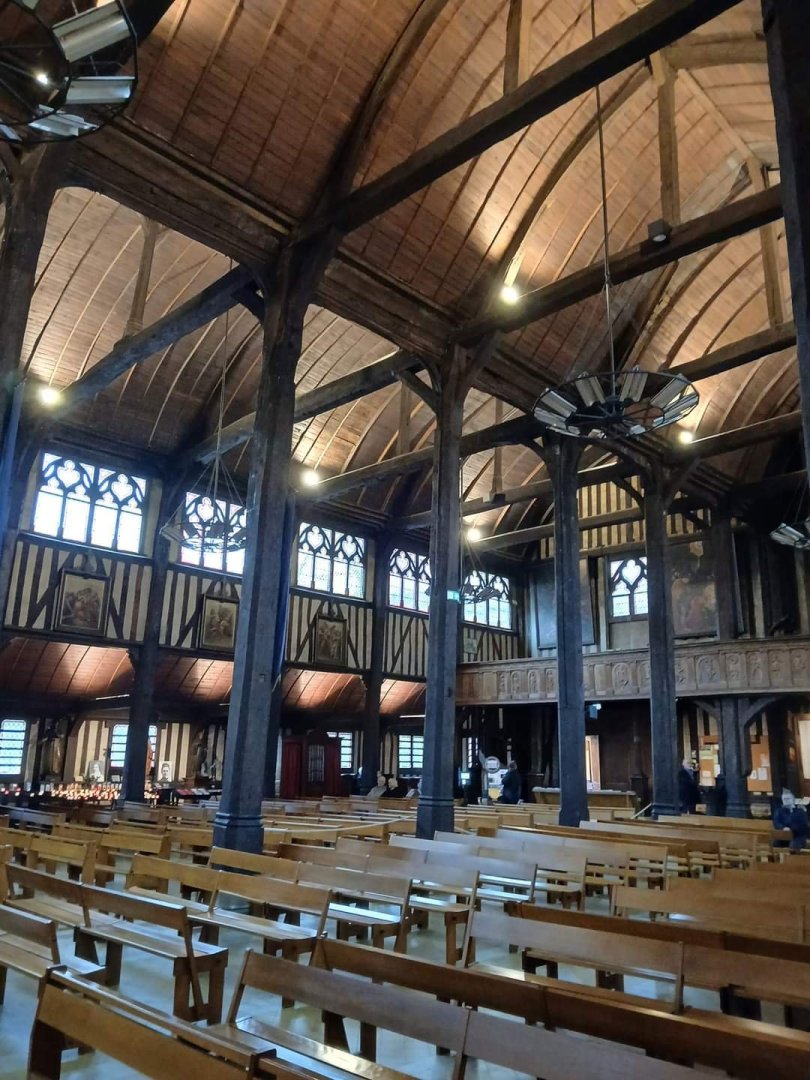-
Posts
3,161 -
Joined
-
Last visited
Content Type
Profiles
Forums
Gallery
Events
Everything posted by Glenn-UK
-
Another masterclass in building. I am looking forward to building the Harpy
- 76 replies
-
- Harpy
- Vanguard Models
-
(and 1 more)
Tagged with:
-
Build Log Index Date: 08/11/2024 Time worked today: 4 hours. Total time spent on build: 124 hours. Futtock Staves and Catharpins I have started to add the futtock staves and catharpins. When adding the futtock staves I used the quad hands to hold the staves in place. I did use a template to make to help position the staves. It was then a case of securing the stave to the shrouds. In the photo below I have secured the staves both ends. I did secure the stave to the middle two shrouds after I took the photo The quad hands were used when adding the catharpins. With the one end of the catharpin thread wrapped around the stave I was able to add the seizing. It did not take two long to complete the process. The next task was to add the ratlines. I used a template for this. I added the ratlines above the stave first. I did mark the template to help with the positioning. When adding the ratlines added all the 1's followed by all the 2’s and then finally all the 3’s. The final task is to add the futtock shrouds, these have been prepared and are ready to be installed.
-
Build Log Index Date: 05/11/2024 Time worked today: 4 hours. Total time spent on build: 120 hours. Topsail Stays To start this post I have attached a photo showing the current build status of my adder. I have now added the topsail mast stays and the back stays. The topsail stays are belayed to the deck via a two block arrangement. The lower block is a single block secured to the deck (main) and hull (fore) via an eyebolt. The inter-block rigging is added to these blocks via an thimble. A double block is added to the end of the stays. I started the process by adding the double block to each of the stays. To do this I make a loop in the stay. The loop is then closed around the block and its position can be adjusted up or down the stay as necessary. As can be seen in the next photo I am checking the position which is just about where I want it to be. Once I was happy with the positioning of the block a second set of seizing was then added. Once that was done the single blocks were seized to the eyebolts and then secured to the deck / hull. Adding and belaying the inter-block rigging was then a straightforward task. The belaying of the main and fore mast stays have also been completed. And finally another photo of the Adder I will now start work on adding the topgallant masts and shrouds.
-
Build Update I have had an enforced 3 week break from building this model. It started when I had an offer to sell my model of the Indy. I took a few days to dust her down and to build a suitable shipping frame. I also hand painted the figure of Captain Pellow. Unfortunately she suffered some damage when the buyer tried to fit her in his car,. It then took me a week to repair the damage, which required two new topgallant masts (Main and Fore) and then removing and then replacing all the topgallant mast and yard rigging. I also had a weeks holiday in France in the middle of all of this mayhem. The repaired Indy has now been delivered to the buyer intact, using a specialist delivery company (Lenspeed). Therefore today I was finally able to return to the Adder build and I will be able to start posting my progress later this week.
-
Sad to see her go, but I had no room for her and happy that she has gone to a place to be displayed.
- 587 replies
-
- Indefatigable
- Vanguard Models
-
(and 1 more)
Tagged with:
-
Many thanks, once I had managed to release the remaining bits of the damaged masts from the caps I was able to work methodically to redo the rigging. The hardest task was to remove the topgallant shrouds from the belaying points.
- 587 replies
-
- Indefatigable
- Vanguard Models
-
(and 1 more)
Tagged with:
-
Goodbye To My Indy I was approached recently to see if I would be interested in selling my Indy. As I did not really have the space for her I was more than happy to let her go. There was not quite enough room in his transport when he came to pick the Indy and sadly the main and fore topgallant mast suffered damage, as can be seen in the photo below. I could have cried and thought a trip to the local tip was on the cards. He was still very keen to have the model so I set about repairing all the damage. I had to make and fit two new topgallant masts. Next I had to redo all the damaged rigging, such as the shrouds, jeers, lifts, braces, stays, back stays, etc. This was a nightmare to do due to the limited access. After a few days hard work the repairs were complete, and most people will be hard pressed to see the repair. The Captain looked impressed. Next I transferred the Indy to a transport shipping frame which should prevent lateral and longitudinal movement. The inner faces of the blocks were felt lined. The client then used a specialist transport company, called Lenspeed. They were fantastic, taking great care to load and adding additional damping and strapping to prevent unwanted movement / vibration during the 2 hours drive. I was a bit sad to see her go, but very happy knowing she has gone to a good home where she will be appreciated.
- 587 replies
-
- Indefatigable
- Vanguard Models
-
(and 1 more)
Tagged with:
-
Build Log Index Date: 09/10/2024 Time worked today: 4 hours. Total time spent on build: 116 hours. Topsail Mast Shrouds Part 2 Work has continued with the topsail mast shrouds. Following on from my last post the next stage in the process was to quickly check the shrouds with the lanyards to see if any further adjustments are necessary. I am using clamps to hold the strops in place for the time being. Happy with how they were looking I went ahead to glue the strops in place and then completed the shroud seizing. When I did the next test fit typically one of the shrouds did not look very good and I did notice its deadeye was upside down. Pity I did not notice a more fundamental problem. More on that later in this post. A block has to be fitted between the first and second shrouds which is used for the yard lifts. It is easier to fit these blocks before the shrouds are fitted. With the block placed between the first two shrouds it is held in position using my quad hands so the seizing could be added. When I started to complete the rigging I finally noticed that I had made a big school boy error when I added the deadeyes to the strops. The deadeyes were pretty firm in the strops, and I was unable to rotate some of them when I tried. I then tried to release the strops from the platform, using a bit of acetone to loosen the glue. I ended up damaging the platform edge when I finally released the first strop. Therefore I have decided to live this error for this model, as once built it will not be on display.
-
Build Log Index Date: 06/10/2024 Time worked today: 4 hours. Total time spent on build: 112 hours. Topsail Mast Shrouds Part 1 As is the norm over recent weeks I seem to be doing plenty of rework. Some is due to silly errors on my part and some due to my completed work could be done much better. This theme has continued with my work on the topsail mast shrouds. I started the process by cutting the required lengths for all the topsail shrouds and then proceeded to make the loops so they could be added to the topsail mast. So far so good! When I did a test fit of the shrouds, I noted two problems. When looking at the next photo the two problems are: a) The shrouds are sitting on top of each other, and it is not possible to position them side by side. The reason for this problem is the seizing thread used was to thick b) The seizing also needs to be positioned to just below the crosstrees as there not enough room between the crosstrees otherwise. The seizing was redone using thinner 0.1mm black thread and looks much better. With the seizing was positioned below the crosstrees it looks much better on the Indy. When adding the deadeyes to the shrouds I have opted to try a new method, which is detailed below. Step 1 – Make a loop and position in the quad hands. Step 2 – Use a simple crossover knot start to the seizing Step 3 – Loop the seizing thread around and make a second crossover knot Step 4 – Repeat step 3 once again. Step 5 – Adjust the position of the loop to the required position. Step 6 – Close the loop around the deadeye and adjust the position as necessary. Step 7 – Check position of the deadeyes are level using the quad hands. Step 8 – After a test fit on the Adder to check the deadeyes are in the right position and look level with each other add the additional seizing. Note: I did test fit the lanyards to check the deadeye positions were OK. I will add more photos when I am ready to add the lanyards.
-
Build Log Index Date: 02/10/2024 Time worked today: 6 hour. Total time spent on build: 108 hours. Main Mast Stays, Topsail Masts and Jibboom Guys It has been an eventful two days. I thought I had completed adding the main mast stay and preventor stay and took a photo to show the progress. The next two photos shows the deadeye lanyard rigging for the main stay and main preventor stay. On closer examination I noted that I had made a couple of errors. The preventor stay should wrap around the top of the main mast, as indicated by the yellow arrow in the next photo. If you look closely, as indicated by the blue arrow, you will see I failed to do this. The red arrow shows that one of the main mast shroud lines is twisted. It took me around 30 minutes to redo the preventor stay and twisted shroud line. Now that I was happy with my work the main and fore topsail masts were added. I decided to add the jibboom guy. This should have been a fairly straight forward task. The two guys (left and right sides) are secured to the end of the jibboom and then pass through eyelets located on top of the spritsail yard and are then secured to the hull via a double block arrangement. On completion of this task I took a photo and noted two errors which I have highlighted with arrows in the next photo. The most obvious error is I used the wrong seizing thread when securing the right-hand side guy to the end of the jibboom. You can see the difference in the next photo, green is OK, red is not OK. The double block arrangement is not symmetrical. The left-hand side is the better arrangement in my opinion. The right-hand side needs to be redone as the gap between the two block is to close in my opinion and compared with the left-hand side.
-
Build Log Index Date: 30/09/2024 Time worked today: 2 hour. Total time spent on build: 102 hours. Lower Mast Stays I thought I would share the method I am using to add the lower stays and preventor stays for the main and fore masts. I started this process by cutting 4 lengths of black thread for the fore and main stays and preventor stays. Each of these threads requires a deadeye to be added. I used my quad hands to complete this activity. In the first photo the deadeye and thread has been positioned in the quad hands. I am aware that the threads are fuzzy in the following photos but this will be sorted out. As per normal I am using a series of crossover knots for the seizing. In the next photo I have just started to add the first seizing. In the next photo the first seizing sequence has been completed. I used 5 lower and 5 upper crossover knots. The next two photos shows a stay with both completed seizing's. I am not a fan of the kit supplied mouse’s and I much prefer to make my own. This is quite easy to do. After determining the approximate position for the mouse I use a length of 0.25mm black thread to add a sequence of 5 lower and 5 upper crossover knots. This is shown in the photo below. Using the same thread I then add a series of 3 lower and 3 upper crossover knots centrally on top and then a single sequence centrally on top. The completed mouse is shown in the photo below. The complete mouse can slide up and down the stay if required. A loop is then added to stay using the crossover knot method. This ensures the seizing and loop size can be adjusted as necessary. The completed stay is then added to the mast so the position of the mouse and loop can be adjusted as necessary, as can be seen in the next photo. The lanyard is also test fitted to check if further adjustments are necessary. The final three photo’s shows the completed test fitting of the fore mast stay and preventor stay. I am happy with how they look.
-
Build Log Index Date: 25/09/2024 Time worked today: 4 hour. Total time spent on build: 100hours. Main and Fore Mast Shroud Deadeye The deadeyes have now been added to the fore and main mast lower shrouds and I am happy with how they look. For the most part my method for setting the position of the deadeyes to the same height within the shrouds worked very well. Photo of Starboard Side Fore Mast Lower Shroud Deadeyes Photo of Starboard Side Main Mast Lower Shroud Deadeyes Photo of Port Side Main Mast Lower Shroud Deadeyes. It will not take me long to add the shroud seizing’s. Despite thinking I have a full proof method for setting the shroud deadeyes to the same height something went awry with the two leading deadeyes as can be seen in the next photo. These were the last two deadeye fitted, some maybe I rushed the process. I reworked the offending two shroud deadeyes and I am now happy with how they look. It will not take me long to add the shroud seizing’s. Port Side Fore Mast Lower Shroud Deadeyes
-
Build Log Index Date: 25/09/2024 Time worked today: 2 hour. Total time spent on build: 96hours. Fore Shroud Deadeye Rework As reported in my last post I was not happy with how the first two fore shroud deadeyes looked, they were not set to the same height, even though the process detailed in my last post usually worked. After carefully unpicking the various seizing threads I started the process once again, with a slight refinement. Using the same jig to determine the deadeye position in the shroud line I inserted the seizing thread to all 4 shroud lines and checked they were all at the same level. The next photo shows the seizing threads in position. With the first two deadeyes inserted in the shrouds the level of the deadeyes was checked. This time around I was much happy with how they look. Confident that the process was working the remaining deadeyes were added to their respective shrouds and the seizing added. As can be seen in the next photo the deadeyes are reasonably level with each other. The lanyards still need a bit of tiding up however. I will now repeat this process for the other shroud lines.
-
Build Log Index Date: 23/09/2024 Time worked today: 1 hour. Total time spent on build: 94hours. Shroud Deadeye Installation Method and Failure When I tackle a task which has a repetitive nature I like to find a method that will yield constant results. Adding deadeyes to the shrouds is one such process especially as I like to ensure the deadeyes are all set to the same height. I came up with a method which helped me to set the shroud deadeye to the same height using a simple jig which I have used on several of my last builds with great success. It is a simple process, using a simple jig, and should ensure all the deadeyes are set to the same height. There are two prongs which are used to locate the jig in channel deadeye. There are two sets of guide pins on the jig which are used to keep the shroud in place. There is a hole near the top of the jig which is used as the point where the deadeye seizing will start. The photo below shows the jig in place. The shroud has been placed between the top and bottom guides and I have used a spring clamp to provide a little bit of tension to the shroud. The seizing thread, with the aid of a needle, is then passed though shroud and then through the hole in the jig. This reason for this is to ensure the seizing is set to the same place on each shroud line. In the photo below the seizing thread has been added. A loop for the deadeye is formed in the shroud which is then held in the quad hands so the seizing can be added, as can be seen in the next two photos. With the shroud still held in the deadeyes the seizing’s above the deadeye are added. In the photo below the first seizing has been added. I did add another seizing whilst the shroud was held in the quad hands. I then repeated the process for the second shroud. As can be seen in the final photo my tried and trusted method has clearly failed spectacularly this time around. I have no explanation why there is such a discrepancy between the height of the first shroud pair. I will remove the deadeyes from these two shrouds and start again. I am also going to think if I can refine the process to prevent such a error occurring.
-
Build Log Index Date: 21/09/2024 Time worked today: 1 hour. Total time spent on build: 93hours. Hammock Cranes I forgot to add the following photo showing the bowsprit, jibboom and spritsail yard I realised I had not added the hammock cranes to the hull and it is much easier to install these before I start work on the shrouds. There are 16 hammock cranes installed each side. I test fitted each crane before they were glued in place. I used wood glue. Once they were all fitted I added the rigging. I have made the fore and main mast shroud pairs and I am now ready to start work in rigging these.
-
Build Log Index Date: 19/09/2024 Time worked today: 2 hours. Total time spent on build: 92hours. Bowsprit Installation I have now started the rigging phase of the build. I started by adding and securing the jibboom and spritsail yard to the bowsprit. Once that was done the bowsprit assembly was added to the hull. The first rigging task was to add the gammoning. Next I rigged the spritsail yard lifts. The next photo shows the spritsail yard tye blocking rigging. I made sure the spritsail yard lifts and tyes rigging was fed through the bowsprit fairlead before they were belayed. The second photo shows the belaying of the spritsail tye to a belaying pin. The final photo shows the belaying of the spritsail yard lifts.
-
Build Log Index Date: 18/09/2024 Time worked today: 4 hours. Total time spent on build: 90 hours. Yard and Bowsprit Manufacture Part 4 I have now completed all the work related to making the yards and booms. The first two photos show the spritsail yard which has been temporarily pinned to the bowsprit. The various deadeyes to the bowsprit will be added later today. The next two photos show the various yards and booms temporarily pinned to the main, main topsail and main topgallant masts. The final photo show the various yards temporarily pinned to the fore, fore topsail and fore topgallant masts.
-
Build Log Index Date: 15/09/2024 Time worked today: 4 hours. Total time spent on build: 86 hours. Yard and Bowsprit Manufacture Part 3 Work is still progressing slowly and steadily with making all the various yards. I have always found this aspect of the build process takes a great deal of time. All work is now complete on the spritsail yard, the fore & main topsail masts, the fore & main topgallant yards, Jibboom and the main &driver booms. I only have to add the PE parts, the various blocks / deadeyes and footropes to the bowsprit and fore & main lower yards which I hope will be completed in the next day or two. The following photo shows all the fore & main mast yards, prior to the final painting phase, and before completion of the lower yards. I decided to add the planking to the hexagonal section of the main and fore lower yards as I think this look much better. The next photo shows the completed spritsail, after painting. I might have to revisit one of the outer footropes and there are not as even as I would like (yellow arrows) The next photo shows the completed fore and main topsail yards. The final photo of this post shows fore and main topgallant yards.
-
Build Log Index Date: 12/09/2024 Time worked today: 4 hours. Total time spent on build: 82 hours. Yard and Bowsprit Manufacture Part 2 Work is progressing slowly and steadily on making the various yards. It is taking me some time to seize all the various blocks required to be added to the yards. It also taking me time to add the footropes. The following is a description of how I added the footropes to the topgallant yards. This first step was to add the footropes to the mid section of the yard. After creating a loop in one end of the two lengths of thread they were positioned on the yard and the seizing was then adjusted to close the loop. Next a loop was formed in the free end of the first thread. My quad hands were used for this. The two photo’s below shows the before and after of this stage. After the loop has been added to the end of the yard the position of the seizing was adjusted. I have found the best position for the seizing is as shown below. The final task was to coat the footrope loops with diluted pva glue. The completed topgallant yards. The blocks have been added to the driver and main boom, as shown in the following photo. The final photo shows the work in progress of the spritsail yard. All the blocks have been seized and are ready to be added. The footropes have been added to one end and the other ends are ready to be added, once the footrope stirrups have been added.
About us
Modelshipworld - Advancing Ship Modeling through Research
SSL Secured
Your security is important for us so this Website is SSL-Secured
NRG Mailing Address
Nautical Research Guild
237 South Lincoln Street
Westmont IL, 60559-1917
Model Ship World ® and the MSW logo are Registered Trademarks, and belong to the Nautical Research Guild (United States Patent and Trademark Office: No. 6,929,264 & No. 6,929,274, registered Dec. 20, 2022)
Helpful Links
About the NRG
If you enjoy building ship models that are historically accurate as well as beautiful, then The Nautical Research Guild (NRG) is just right for you.
The Guild is a non-profit educational organization whose mission is to “Advance Ship Modeling Through Research”. We provide support to our members in their efforts to raise the quality of their model ships.
The Nautical Research Guild has published our world-renowned quarterly magazine, The Nautical Research Journal, since 1955. The pages of the Journal are full of articles by accomplished ship modelers who show you how they create those exquisite details on their models, and by maritime historians who show you the correct details to build. The Journal is available in both print and digital editions. Go to the NRG web site (www.thenrg.org) to download a complimentary digital copy of the Journal. The NRG also publishes plan sets, books and compilations of back issues of the Journal and the former Ships in Scale and Model Ship Builder magazines.




